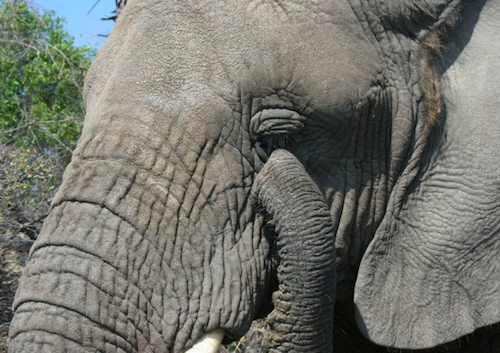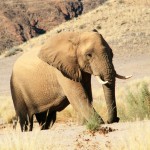by Cindy Tilney

The trampling of a Namibian trophy hunter by an elephant has reignited the heated debate around hunting permits issued for the country’s gravely endangered desert elephants.
In a strange twist of fate earlier this month, a young bull elephant in the far north of the country trampled and injured a Namibian professional hunter assisting a German trophy hunter who is allegedly “licensed to shoot and kill elephants in the conservancy”, according to a report in the New Era.
The bull was subsequently shot by wildlife authorities, making it the second elephant to be killed in the region in recent weeks.
Conservationists have been outraged over the government’s issuing of permits to hunt desert-adapted elephants found in Namibia’s northwestern reaches. Renowned conservationist Garth Owen-Smith recently highlighted the dwindling numbers of these unique creatures, saying ‘this population of between 120 and 150 elephants that live most of their lives in the northern Namib are of enormous value to the country and the world’.
According to sources on the ground, of these 120-odd animals, only 18 are mature bulls – a fact which has enormous implications for the breeding potential – and ultimately survival – of the group.
These two trophy kills come on the heels of a press release by the Ministry of Environment and Tourism, in which they stated that only two ‘own-use’ hunting permits had been issued to conservancies in Namibia’s northwestern region. What the MET conveniently failed to mention in that statement is that another seven trophy hunting permits have been issued – a fact since confirmed by MET PRO, Romeo Muyunda.
The two bulls killed so far have both been of breeding age. After the slaughter of the first bull, Delta, a member of the Namibian Professional Hunter’s Association commented on the matter, saying, “While I am completely in favour of sustainable hunting, I don’t feel entirely comfortable with the idea of shooting elephants in the Kunene region – particularly if they are of breeding age, as this bull was.”
Despite repeated requests to the MET to identify the conservancies in which the remaining permits have been issued, no response has been forthcoming. The government’s reluctance to disclose this information is deeply concerning given the controversial nature of the territory in which the two bulls have already been killed.
Suzi Van de Reep, co-owner of the Kunene region’s Huab Lodge,said, “I am horrified by what is happening. At the start of the century, we had 13 bulls who used to visit regularly – we could virtually set our clocks by their arrival to dig waterholes in the dry riverbed. Then, within a space of three years, we lost every single one of them to the gun – simply and solely because of hunting permits issued by the MET. And the tragedy is, it’s not stopping. The government has to realise that these elephants are not replaceable.”




